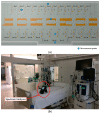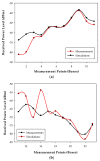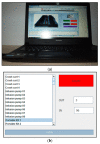Implementation and Operational Analysis of an Interactive Intensive Care Unit within a Smart Health Context
- PMID: 29382148
- PMCID: PMC5854996
- DOI: 10.3390/s18020389
Implementation and Operational Analysis of an Interactive Intensive Care Unit within a Smart Health Context
Abstract
In the context of hospital management and operation, Intensive Care Units (ICU) are one of the most challenging in terms of time responsiveness and criticality, in which adequate resource management and signal processing play a key role in overall system performance. In this work, a context aware Intensive Care Unit is implemented and analyzed to provide scalable signal acquisition capabilities, as well as to provide tracking and access control. Wireless channel analysis is performed by means of hybrid optimized 3D Ray Launching deterministic simulation to assess potential interference impact as well as to provide required coverage/capacity thresholds for employed transceivers. Wireless system operation within the ICU scenario, considering conventional transceiver operation, is feasible in terms of quality of service for the complete scenario. Extensive measurements of overall interference levels have also been carried out, enabling subsequent adequate coverage/capacity estimations, for a set of Zigbee based nodes. Real system operation has been tested, with ad-hoc designed Zigbee wireless motes, employing lightweight communication protocols to minimize energy and bandwidth usage. An ICU information gathering application and software architecture for Visitor Access Control has been implemented, providing monitoring of the Boxes external doors and the identification of visitors via a RFID system. The results enable a solution to provide ICU access control and tracking capabilities previously not exploited, providing a step forward in the implementation of a Smart Health framework.
Keywords: 3D Ray Launching; Intensive Care Unit; Smart Health; hospital; radio planning; visitor control application.
Conflict of interest statement
The authors declare no conflict of interest.
Figures






















Similar articles
-
Integration of Autonomous Wireless Sensor Networks in Academic School Gardens.Sensors (Basel). 2018 Oct 25;18(11):3621. doi: 10.3390/s18113621. Sensors (Basel). 2018. PMID: 30366409 Free PMC article.
-
Performance Evaluation and Interference Characterization of Wireless Sensor Networks for Complex High-Node Density Scenarios.Sensors (Basel). 2019 Aug 11;19(16):3516. doi: 10.3390/s19163516. Sensors (Basel). 2019. PMID: 31405238 Free PMC article.
-
Analysis of wireless sensor network topology and estimation of optimal network deployment by deterministic radio channel characterization.Sensors (Basel). 2015 Feb 5;15(2):3766-88. doi: 10.3390/s150203766. Sensors (Basel). 2015. PMID: 25664434 Free PMC article.
-
Challenges in Wireless System Integration as Enablers for Indoor Context Aware Environments.Sensors (Basel). 2017 Jul 12;17(7):1616. doi: 10.3390/s17071616. Sensors (Basel). 2017. PMID: 28704963 Free PMC article.
-
Operations research in intensive care unit management: a literature review.Health Care Manag Sci. 2018 Mar;21(1):1-24. doi: 10.1007/s10729-016-9375-1. Epub 2016 Aug 12. Health Care Manag Sci. 2018. PMID: 27518713 Review.
Cited by
-
Using Explainable Machine Learning to Improve Intensive Care Unit Alarm Systems.Sensors (Basel). 2021 Oct 27;21(21):7125. doi: 10.3390/s21217125. Sensors (Basel). 2021. PMID: 34770432 Free PMC article.
-
Sensors for Context-Aware Smart Healthcare: A Security Perspective.Sensors (Basel). 2021 Oct 17;21(20):6886. doi: 10.3390/s21206886. Sensors (Basel). 2021. PMID: 34696099 Free PMC article. Review.
-
Deterministic Propagation Modeling for Intelligent Vehicle Communication in Smart Cities.Sensors (Basel). 2018 Jul 3;18(7):2133. doi: 10.3390/s18072133. Sensors (Basel). 2018. PMID: 29970826 Free PMC article.
-
Integration of Autonomous Wireless Sensor Networks in Academic School Gardens.Sensors (Basel). 2018 Oct 25;18(11):3621. doi: 10.3390/s18113621. Sensors (Basel). 2018. PMID: 30366409 Free PMC article.
-
Narrowband Characterization of Near-Ground Radio Channel for Wireless Sensors Networks at 5G-IoT Bands.Sensors (Basel). 2018 Jul 26;18(8):2428. doi: 10.3390/s18082428. Sensors (Basel). 2018. PMID: 30049959 Free PMC article.
References
-
- Solanas A., Patsakis C., Conti M., Vlachos I.S., Ramos V., Falcone F., Postolache O., Perez-Martınez P.A., Di Pietro R., Perrea D.N., et al. Smart Health: A Context-Aware Health Paradigm within Smart Cities. IEEE Commun. Mag. 2014;52:74–81. doi: 10.1109/MCOM.2014.6871673. - DOI
-
- Shieh J., Fu M., Huang S., Kao M. Comparison of the Applicability of Rule-Based and Self-Organizing Fuzzy Logic Controllers for Sedation Control of Intracranial Pressure Pattern in a Neurosurgical Intensive Care Unit. IEEE Trans. Biomed. Eng. 2006;53:1700–1705. doi: 10.1109/TBME.2006.873757. - DOI - PubMed
MeSH terms
LinkOut - more resources
Full Text Sources
Other Literature Sources

